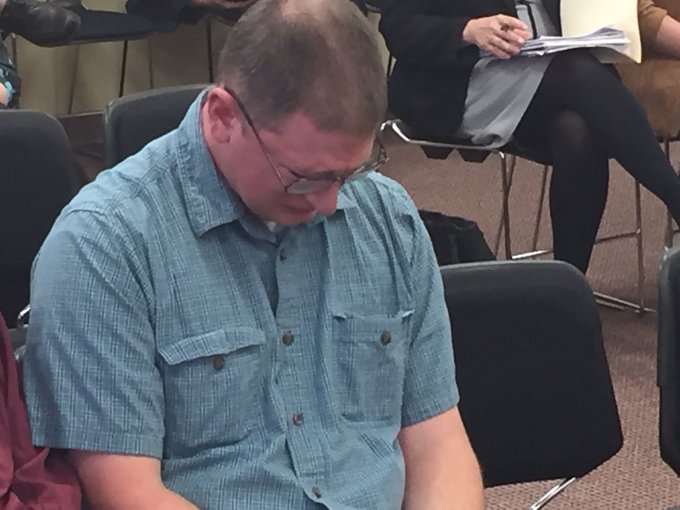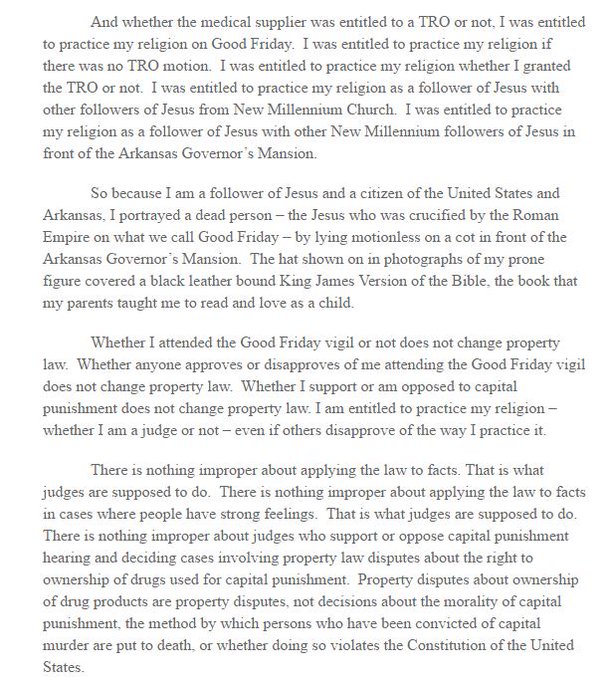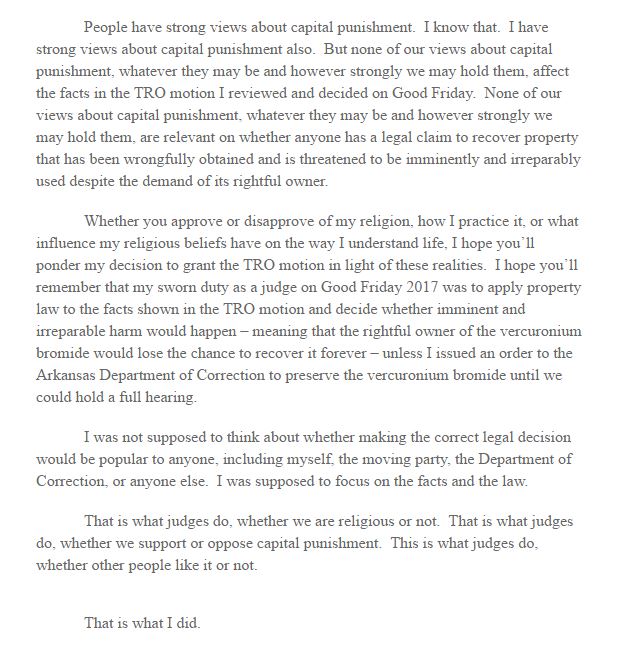
ACUL/Mugshot Ledell Lee DNA tests raise questions.
Ledell Lee was a convicted murderer who was executed by the State of Arkansas after being represented by an intoxicated attorney and insisting he was innocent. Now DNA tests are raising serious new questions about his guilt in the death of Debra Reese.
Lee was convicted in the brutal murder of Reese in her home with a tire thumper.
According to The Washington Post, attorneys for Lee’s family say they found new DNA profiles that are not Lee’s DNA on the handle of the blood club used to slay Reese and a shirt wrapped around it. An attorney told The Post, though, that the DNA results are “incomplete and partial.”
“While the results obtained 29 years after the evidence was collected proved to be incomplete and partial, it is notable that there are now new DNA profiles that were not available during the trial and post-conviction proceedings in Mr. Lee’s case,” said Nina Morrison, senior litigation counsel for the Innocence Project, according to Arkansas Online. Read past Innocence Project articles on the case here. Read the Lee family lawsuit that resulted in the new DNA tests here.
Meanwhile, Arkansas officials are defending Lee’s executive despite the new evidence.
THV11 reported: “The testing concluded that there is ‘moderate support’ that blood on Lee’s left shoe could belong to victim Debra Reese.”
Ledell Lee was put to death in April 2017, according to CNN, despite a flurry of court actions. Lee maintained that he was innocent in the 1993 slaying of Debra Reese. A tire thumper is a device used to check tire pressure in trucks.
“Since Ledell’s execution, we have discovered a wealth of new evidence supporting his claim of innocence,” Morrison said in a press statement. “All of this evidence should have been presented to the courts while Ledell was still alive, but it wasn’t because he couldn’t afford a quality defense. We know that 167 people have been exonerated from death row for crimes they did not commit, many after losing decades of their life behind bars. The lack of thoroughness in Ledell’s investigation helps explain how that happens.”
According to the Innocence Project, the courts primarily rejected Lee’s request for new DNA testing because they said it came too late, on the eve of his execution.
Human rights groups argued on Lee’s side before he was put to death in 2017. In one odd twist, it was revealed the judge was having an affair with the prosecutor, whom he later married, the ACLU contended. According to Arkansas Online, the evidence against Lee was primarily “eyewitness testimony, a shoe imprint and the serial number of a $100 bill he was accused of lifting” from the victim.
According to Slate, then new Supreme Court Justice Neil Gorsuch “cast the deciding vote allowing Lee to die” – his first recorded Supreme Court vote. The majority didn’t explain its decision.
Lee’s death was part of a flurry of executions that the State of Arkansas was trying to rush through that year. “Arkansas set out to execute eight people over the course of 11 days,” dissenting Justice Stephen Breyer wrote. “Why these eight? Why now?…apparently the reason the State decided to proceed with these eight executions is that the ‘use by’ date of the State’s execution drug is about to expire. In my view, that factor, when considered as a determining factor separating those who live from those who die, is close to random.”
Arkansas said it was rushing the executions through because a drug it uses to administer lethal injections was set to expire.
.
Multiple courts intervened in a variety of ways to halt the speedy execution plan, and some of the inmates scheduled to die won reprieves. However, courts rejected Lee’s efforts to have new evidence testing, and he was put to death.
Here’s what you need to know:
1. Lee’s Attorneys Unsuccessfully Tried to Get the New DNA Tests Before He Was Executed
The family’s lawsuit that posthumously won the new DNA testing said that “no physical evidence directly tied Mr. Lee to the murder” but the state convicted him by “vastly overstating the nature and significance of the limited forensic testing conducted at the time, including tests that its own experts admitted were ultimately ‘inconclusive.’ The state also relied heavily on alleged identifications of Mr. Lee by neighborhood eyewitnesses, even though that testimony contained notable inconsistencies in the witnesses’ descriptions of the perpetrator.”
According to Slate, Lee’s attorneys tried to get new DNA testing before he was put to death, but it was not allowed. It was only after a lawsuit from his sister after his death that the new tests went ahead.
According to Slate, the other unknown man’s DNA was found “on the murder weapon, a wooden club, and on a shirt that had been wrapped around the murder weapon.”
Slate reported that fingerprints at the crime scene did not match Lee or anyone in a national database but haven’t been tested against the Arkansas State Crime Laboratory’s database. Six hairs were found with Lee being excluded in five; he could not be excluded in the sixth although that’s true of many people, Slate reported.
Slate noted, “Lee’s first trial ended in a hung jury. At his second one, his lawyers did not bring up some of the potentially exonerating testimony and evidence raised in the first, including alibi testimony from Lee’s family members.”
Governor Asa Hutchinson is still defending the execution, saying in May 2021 in a press conference, “Whenever you make tough decisions or whenever you have to carry out the decision of a jury, you realized it’s been reviewed by the Supreme Court at every level. They confirm the convictions and it’s my duty to carry out the law. The evidence that was obviously uncovered is inconclusive and the fact is that the jury found him guilty based upon the information that they had.”
Attorney General Leslie Rutledge is too, telling THV11: “The courts consistently rejected Ledell Lee’s frivolous claims because the evidence demonstrated beyond any shadow of a doubt that he murdered Debra Reese by beating her to death inside her home with a tire thumper. After 20 years, I am prayerful that Debra’s family has had closure following his lawful execution in 2017.”
An ACLU press statement in January said, “When the Innocence Project and the ACLU were brought in to work on his case less than two weeks before his execution, they immediately identified serious flaws in the evidence used to convict him. They also identified DNA evidence that likely belonged to the killer and had never been tested with modern technology. The courts refused to hear any new evidence or allow DNA testing before executing Lee, who was one of eight people scheduled for execution in rapid succession because of the state’s expiring supply of execution drugs.”
“My family has been unable to rest for the last two and a half years, knowing that my brother was murdered by the state of Arkansas for a crime we believe he did not commit,” said Patricia Young, sister of Ledell Lee. “What happened to Debra Reese is horrible, and we keep her family in our prayers. But I was with Ledell the day this murder happened, and I do not see how he could have done this. If Ledell is innocent, then the person who did this has never been caught. All we want is to finally learn the truth.”
2. Lee, a Serial Rapist, Was Convicted of Beating Debra Reese to Death With a Truck Thumper
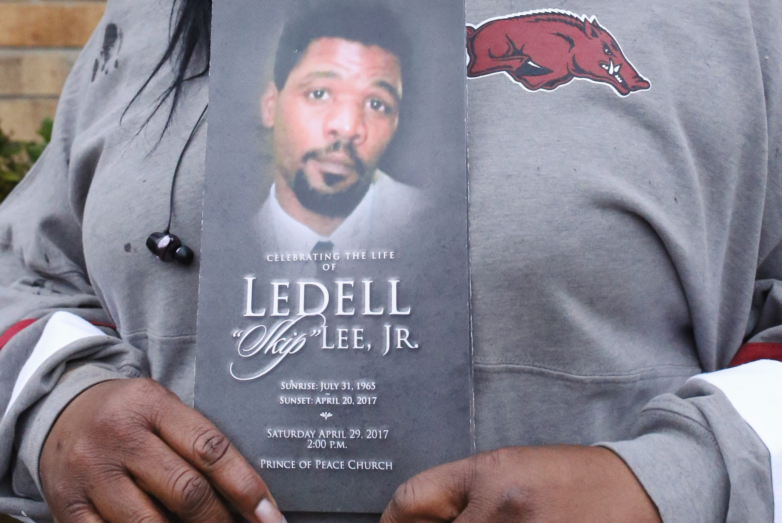
Innocence ProjectLedell Lee flyer
Although he claimed he was innocent, Lee was convicted in the murder of Debra Reese. According to THV-11, Reese was raped and murdered in her home in 1993 at age 26 and was “struck approximately 36 times with a tire thumper, a tool used by truck drivers to check their tire pressure.” Her husband had given it to her for protection because he was a trucker who was often gone, the television station reported.
In 2017, Arkansas AG Leslie Rutledge said in a press statement, “On the morning of the murder, Lee had been going door to door in Reese’s neighborhood asking to borrow tools. Lee, a serial kidnapper and rapist, targeted Reese after he discovered she was home alone. Reese was last heard from when she telephoned her mother to tell her about the encounter with Lee, which left her uneasy. Reese’s battered body was discovered in her bedroom later that same day.”
Reese was also strangled, reports The Arkansas Times.
According to THV, Lee was arrested after “witnesses claimed they saw him walking down the street that Reese’s house was on.” Crime and Capital Punishment reports, “Lee, who had just been paroled after serving time for burglary, was arrested an hour after the murder when witnesses reported seeing him walking the street.”
The television station reports that Lee was suspected of other crimes by authorities, including the strangulation and rape of another woman, but that trial ended in a hung jury. He was also convicted of two other rapes, reported THV.
“Lee was convicted for the rape of two Jacksonville women and was accused of the murder and rape of 22-year-old Christine Lewis,” reports WZZM, which notes that prosecutors dubbed him a “super predator.”
“In November 1989, Lewis was abducted from her home where she was later raped, strangled, and eventually killed. Her body was later found at an abandoned home inside a closet. That trial ended in a hung jury,” reports WZZM, which adds that prosecutors didn’t retry him in that murder only because he received the death penalty in the slaying of Reese.
According to Arkansas Matters, “The ages of Lee’s victims ranged from 17 to 70” and prosecutors called him a “psychosexual serial rapist.”
An appeal he filed in the case said he was raised in a family of “crushing poverty” where food and adult care were scarce. His mother was 16 and drank alcohol throughout the pregnancy, the appeal says.
According to Arkansas Online, Lee’s shoes “contained drops of human blood” but it was too small a sample for testing back then. The site added that Reese’s neighbor “testified that he tailed Lee on the day of Reese’s murder after becoming suspicious when he barged into Reese’s home and left while repeatedly looking over his shoulder.”
3. The Judge Had an Affair With a Prosecutor & Lee’s Attorney Was Drunk in Court, the ACLU Contends
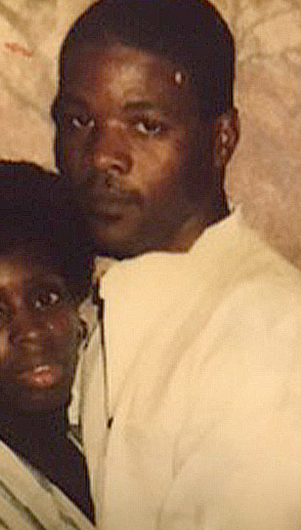
Innocence ProjectLedell Lee
The ACLU reports that Lee argued in court that “he has fetal alcohol syndrome disorder, significant brain damage, and intellectual disability. These facts were concealed by the line of counsel plagued with conflicts of interests, substance abuse, serious mental illness, and gross incompetence.”
One of his appeals claimed that some of his lawyers were alcoholics and one was mentally ill.
There were other odd and disturbing twists in the case. “Lee was tried by a judge who concealed his own conflict of interest: an affair with the assistant prosecutor, to whom the judge was later married. Mr. Lee’s first state post-conviction counsel introduced the evidence of the affair by calling the judge’s ex-wife, who testified about the affair after opposing the subpoena. That lawyer, however, was so intoxicated at the hearing that the state moved for him to be drug tested after he slurred, stumbled, and made incoherent arguments,” the ACLU reports.
The Innocence Project reports that Lee wanted new DNA testing in the case: “Numerous unknown fingerprints were found at the crime scene, yet none were from Lee. At trial, the prosecution claimed that two small spots of ‘human blood’ on shoes recovered by the police from Lee were likely the victim’s blood. Yet despite the extremely bloody nature of the crime, no other blood was found anywhere on Lee’s shoes, or any of his clothing. Newly available DNA testing could prove whether the spots were in fact victim’s blood.”
The Innocence Project said at the time of the execution that there are also hairs it wanted tested that “the state’s experts claimed that the hairs were ‘consistent’ with Lee’s based on microscopic examination – a forensic method that has since been discredited.”
According to The Arkansas Times, Lee’s attorneys “argued that they should be allowed to locate crime scene evidence collected in 1993, including a single hair and a Converse shoe with a pinhead-sized spot of human blood on it, for modern DNA testing. They hope testing can prove that the African-American hair found at the crime scene belongs to someone other than Lee, and that the speck of blood found on Lee’s shoe does not belong to the victim in the case.”
4. Lee Asked for His Last Meal to be a Communion Host After the Supreme Court, Including Gorsuch, Allowed the Execution to go Forward
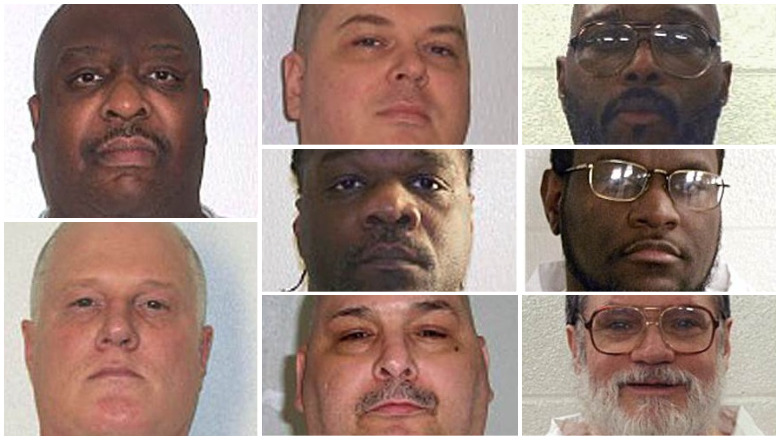
MugshotsThe eight inmates that Arkansas is trying to put to death. (Correctional photos)
The U.S. Supreme Court was asked to stay Lee’s execution but ultimately declined to do so. The Supreme Court decision to allow the state to execute Lee was 5-4, reports The New York Times, which said that Neil Gorsuch joined the majority, which did not explain its decision. Breyer, in a dissent, complained about the state’s rationale that it needed to execute the prisoners before a drug expiration date, the Times reported.
“The U.S. Supreme Court declined to hear five last-minute appeals by Lee’s attorneys to stay his execution, which began at 11:44 p.m. CT (12:44 a.m. ET). Lee was pronounced dead at 11:56 p.m,” reports NBC News.
Lee’s last meal request? Communion. “He declined to make a final statement, officials said. Three media witnesses reported that Lee remained under sedation during the procedure,” reported NBC News.
According to the New York Times, Lee received three drug injections: “midazolam, to render him unconscious; vecuronium bromide, to halt his breathing; and potassium chloride, to stop his heart.” The first drug is the subject of controversy after previous “botched” executions with it, The Times reports.
You can read U.S. Supreme Court documents in Lee’s case here.
He received communion but because the host and wine that came with it were not considered a “full meal,” the “Department of Correction offered to provide a meal on his behalf to the rest of the prison population. Lee declined,” NBC reports.
5. Reese’s Son Called Lee the ‘Embodiment of Evil’
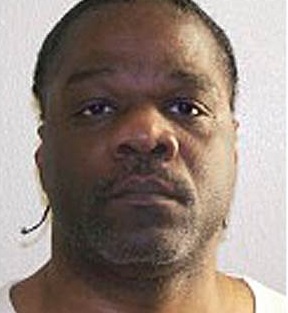
Correctional photoLedell Lee correctional photo.
Reese’ son has called Lee the “embodiment of evil that should never have to exist in this world,” reported THV. According to WZZM, Joseph Lucky “was a young child when his mother was murdered 24 years ago. To Lucky, his mother was everything to him. He has spent most of life hoping for justice and, most of all, closure for the death of his mother.”
“When she was ripped from my life it started spiral I almost didn’t recover from,” Lucky told WZZM, “and my family has lived in the shadow of this event our entire lives.”
The rapid pace of compressed executions the state wants to carry out would make it unique since at least 1976. According to The Chicago Tribune, “The state set the compressed schedule because its supply of one of the lethal injection drugs expires at the end of April” 2017.
The eight executions – almost one per day – “would have been the most by a state in such a compressed period since the U.S. Supreme Court reinstated the death penalty in 1976,” reported ABC News.
The state hadn’t put anyone to death for a decade, according to The Huffington Post.
According to The New York Daily News, “Midazolam is a common sedative used typically by medical doctors. The drug is designed to sedate or relax the patient before undergoing minor surgical procedures,” and it has been used in executions since 2013 but there have been reports of inmates waking up.
A drug company has gone to court to try to halt the execution plan, and it initially won a critical ruling. The practical effect of an April 19 ruling was that it stopped the state’s plan to put all eight inmates to death. But then the Arkansas Supreme Court reversed that ruling, paving the way for Lee’s execution.
According to The Huffington Post, McKesson Corp, which supplied the drug pancuronium bromide to Arkansas, argued in court that the “state misleadingly obtained its product.”
Pancuronium bromide is step two in a “three-drug cocktail” the state uses to put inmates to death, paralyzing the prisoner, reported Huffington Post.
There was an odd twist. The week before, a different judge, Wendell Griffen, issued a similar ruling – saying the state couldn’t use the drug vecuronium bromide – “but the Arkansas Supreme Court vacated Griffen’s ruling days after he participated in an anti-death penalty rally,” ABC News reported.
In a statement, Griffen explained why he lay motionless on a cot in front of the Arkansas governor’s mansion:
The company claims that it was “led to believe that the order was placed at the request of or for the benefit of the licensed physical and would be used for a legitimate medical purpose… In fact (Arkansas) intended to use this product in connection with executions, a fact that was never disclosed to McKesson.”
READ NEXT: James Brian Chadwell Investigated as Possible Suspect in Notorious Delphi Murders of Two Girls.
